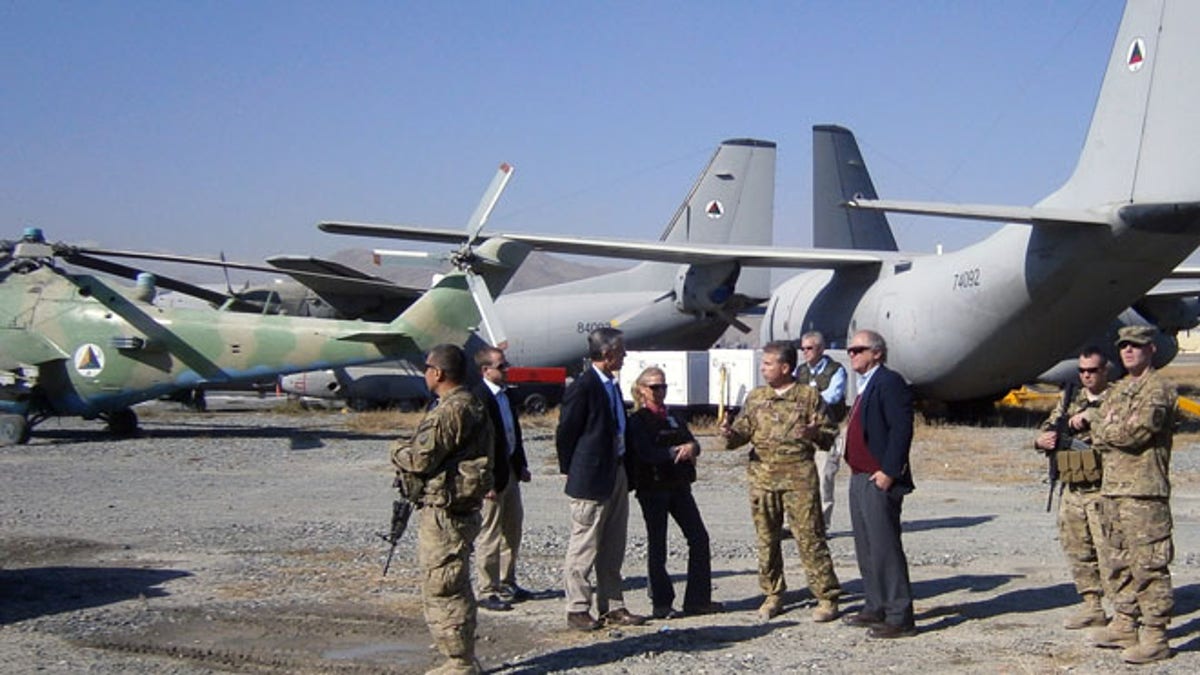
Shown here are G222 aircraft sitting on an airfield at Kabul International Airport. (Office of the Special Inspector General for Afghanistan Reconstruction)
How much "stuff" is the United States military leaving behind as it withdraws from Afghanistan after 12 years of war? Try some $6 billion worth.
And much of it may yet end up in a junk pile.
That includes 850 MRAPS (Mine-Resistant Ambush Protected) vehicles which have been credited with saving countless lives from improvised explosive devices (IEDs) on the road, but now will either be given to an allied country (as long as they pay the shipping costs) or for scrap on the Afghan market.
This calculation is being done over and over, as U.S. military officials weigh what to bring home and what to leave in the battlefield. As Afghanistan heads into elections this weekend, U.S. forces are preparing for a total, or almost total, withdrawal by the end of the year.
Ultimately, some 170 million pounds of vehicles, equipment and "white gear" -- that's all the non-military stuff that contractors have been using, like furniture, generators, chemical toilets, air conditioners, non-classified computers and more -- are being left behind. What they cannot, or will not, donate or sell to the Afghans or to allies is being destroyed so that it doesn't rot in place or fall into Taliban hands. Some reports indicate that most of the $6 billion worth of materiel will indeed be sold for scrap or thrown in the junkyard.
Pentagon officials would not confirm that, but consider this: in the month of February alone, Defense Logistics Agency (DLA) Disposition Services sold 34.7 million pounds of scrap from its own vehicles and equipment to local Afghan vendors, according to figures provided to FoxNews.com.
And in the past 12 months, the agency sold 387 million pounds of scrap, sending $46.5 million back to the U.S. Treasury.
Officials say it's the only alternative to shipping everything back to the States, which by air or through dangerous land routes via Pakistan would be entirely cost-prohibitive.
"You don't really have any great options," said Lawrence Korb, a former assistant secretary of Defense under the Reagan Administration and now senior fellow at the Center for American Progress. "At least in Iraq, you had Kuwait where you could have a place to store [vehicles and equipment]. They are making the best of no great choices."
Pentagon spokesman Mark Wright said the military has, over the last 12 years, donated "excess equipment" like base-operating support equipment, forklifts, generators and other supplies to the Afghan National Security Forces (ANSF), and has invested more than $53 billion in equipment and support -- including 160 aircraft, 100,000 vehicles, 500,000 weapons and 200,000 pieces of communications and night-vision equipment.
According to reports and officials, though, the U.S. donated much more of its materiel and equipment to the Iraqis when it withdrew from that country in 2011 -- about $580 million worth. The Iraqis also planned on buying another $10 billion worth of military equipment from the U.S.
Pentagon officials did not speculate or comment as to why. But military experts like Korb and others told FoxNews.com that the Iraqis could handle the sophisticated equipment and had the money to maintain it. Afghanistan is not the same situation.
"[The Afghans] don't have the requisite skills to maintain these things," noted Lt. Col. Daniel Davis, who served in Afghanistan as an Army acquisition chief from 2011-2012. Furthermore, there is no supply chain for spare parts, particularly for the MRAPs, he said, "so they probably go to the bone yards."
This might be particularly frustrating to American taxpayers who helped pour billions of dollars into training the Afghan forces over the last 12 years.
Korb pointed out that the two militaries -- Iraq and Afghanistan -- are worlds apart. "In Iraq, don't forget, before the war you had pretty good military. We disassembled it, and that was a mistake, but in terms of their fighting ability they were pretty sophisticated. Afghanistan never had a military like that."
Further, unlike the U.S. withdrawal from Iraq, there is a war still going strong in Afghanistan, said Korb.
"If you give that stuff to the Afghan or even the Afghan Security Forces, it could still end up with the Taliban. You have to err on the side of caution. The last thing you want is to read in the papers that some sophisticated piece of equipment was used to bomb an American base or something like that."
According to figures supplied by Army spokesman Wayne Hall, there is currently $15.5 billion worth of Army equipment still in the country -- and $17.6 billion worth of overall U.S. military equipment, Wright said. The Army plans to retain $10.2 billion of that, including things like trucks, trailers, and MRAPs, as well as about 100,000 20-foot shipping containers carrying repair parts and other small equipment and supplies.
"Divesting" (or leaving vehicles and materiel behind), Hall said in an email to FoxNews.com, provides "a cost avoidance of $844 million in transportation, storage, and security costs. Some excess equipment is simply cheaper to divest than retrograde, reset, or retain."
At height of the Iraq War, after a delay that brought swift rebuke from Washington lawmakers, tens of thousands of MRAPs were sent into the country to help reduce troop fatalities and catastrophic injuries caused by IEDs planted all along the roads by insurgents. Many were shipped to Afghanistan at the end of the Iraq War.
"According to Wright, several allied countries have inquired about receiving MRAPs but so far none as far as he knew had "signed on the dotted line."
But some observers say more MRAPs might have been shipped overseas than was even necessary, and billions of dollars could have been saved if better planning had gone into the process -- especially since the MRAP, outside Afghanistan, is rapidly becoming obsolete.
"I think it is clear they made massively more than what was ever needed," Davis said. "I would argue [the MRAP] would provide limited utility in a conventional war -- they are absolutely road-bound" and not anything like a tank, he added.
There have been other alleged missteps. Among other expenses, the inspector general for Afghanistan reconstruction has been probing a half-billion dollars spent on providing refurbished aircraft to the Afghan Air Force, only to abandon the contract and leave the planes collecting dust on airfields in Kabul and Germany. Part of the problem was an apparent failure to acquire the spare parts needed to keep the planes operational.
But Pentagon officials balk at the criticism that the military has generated waste throughout the war. Officials told FoxNews.com they are trying very hard to find homes for the MRAPs and have donated a lot of other equipment and "white gear" to the Afghans as the many massive forward operating bases (FOBs), which once housed tens of thousands of troops and support personnel, are broken down.
What they can't get rid of lands in the junk heap or the scrap yard, but it's usually because the Afghan government doesn't want it.
Meanwhile, there are other items that are being trashed that local Afghans potentially could use -- like washing machines, treadmills, or any household item with a timer.
But Wright explained that non-military items with timing equipment and other components can still pose a threat.
"For example, timers can be attached to explosives. Removing those timers or other potentially dangerous internal components renders the property inoperable and so it is scrapped," Wright said.
Afghans who spoke with the Associated Press last November said the junkyards are towering with American cast-offs. "These are things we can use at home with our families or in our business," Kandahar junk dealer Mir Ahmed told the AP. "But instead they turn everything to junk and then they give it to us."
While military experts say this is typical in any war, and particularly a protracted and costly one like Afghanistan, Davis said there was a lot sent over to the country that was never utilized in the first place and might never be used again.
"We're just not giving a lot of thought to what comes next -- is it sustainable? Can we use it afterward? The answer is, it just doesn't matter," he said. "It doesn't seem that we even care about this significant amount of waste."




